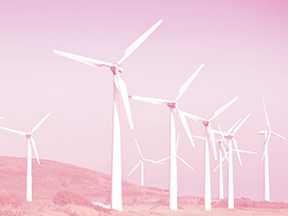Humans have been harnessing wind power for thousands of years. Since nearly the beginning of recorded history, we’ve used energy from the wind to grind grain, pump water, and move seagoing ships. By the late 1800s, we’d unlocked the early potential of windmills to generate electricity. And today, we produce enough wind energy in the U.S. alone to power tens of millions of homes.

According to the U.S. Energy Information Administration (EIA), world energy consumption is predicted to increase by almost 50% between 2018 and 2050. That’s in part due to the ever-growing industrial sector, which includes manufacturing, agriculture, and construction, and accounts for an overwhelming share of the planet’s energy consumption.
As the world’s population (and consumption of goods) increases, we’ll rely more and more upon clean, renewable energy sources to power these important industrial applications, while minimizing air pollution and emissions tied to fossil fuels. That’s why we’ve seen growing momentum behind wind power: a remarkably sustainable, affordable solution for the renewable energy sector.

Wind Power in the U.S. Today: Stats & Insights
Based on data from the Office of Energy Efficiency & Renewable Energy (EERE), wind power capacity in the U.S. reached about 122,000 MW by the end of 2020, making it the biggest source of renewable energy in the country. For context, wind energy accounted for a little over 8% of total U.S. energy generation in 2020 (EERE). This is made possible through the use of utility-scale wind turbines, which are growing in size, complexity, and capacity each year. Larger turbines can safely reach higher into the air, where wind speeds and the potential for capturing electricity increase.
Wind energy has the strongest foothold in Oklahoma, South Dakota, North Dakota, Iowa, and Kansas, according to the EERE. These states can rely on wind energy for over 30% of their electricity needs! Though perhaps the greatest opportunity for wind power lies in U.S. states with high-population coastal cities.
Developing Offshore Wind in the U.S.
Offshore wind power involves the installation of wind farms on different bodies of water. This is done because higher wind speeds are possible offshore vs. on land, which results in greater electricity generation. And because about 80% of Americans live within 200 miles of the coast, offshore wind has huge potential as an inexhaustible, cost-effective power source for these communities.

While European countries currently lead the way in offshore wind, this clean energy movement is gaining momentum in the U.S. as well. In fact, by 2050, the U.S. Department of Energy predicts that we could tap into a total of 86,000 MW through offshore wind projects alone (ACP). Investing in offshore wind could help U.S. cities and businesses near the coast secure large supplies of dependable, affordable power—while creating tens of thousands of jobs and massive economic impact through offshore wind development projects.
A Rising Wind for Clean, Affordable Energy
Conventionally, one of the greatest roadblocks to wind power systems has been cost. However, thanks to innovations in wind farm technology, the weighted-average LCOE (levelized cost of energy) for onshore wind projects has been steadily decreasing in the U.S., among many other countries worldwide. Today’s wind farms use a variety of control and automation technologies to further reduce wind turbine operating and maintenance costs, creating powerful long-term energy solutions that pay for themselves over time.

KEB Solutions for Wind Power
At KEB, we offer a range of flexible control and automation tools to help turbine designers combat vibration, extreme temperatures, and other inherent challenges in the wind power sector. Our adaptable solutions are designed to prevent any downtime in critical turbine systems, while maximizing cost-efficiency and safety.
For example, KEB COMBISTOP spring-set brakes are an ideal option for holding the pitch blades of wind turbines in place. These spring-applied brakes feature versatile mountings—as well as extreme temperature versions to resist harsh environmental conditions. COMBISTOP brakes support safe, dependable wind power operations by ensuring safe positioning of the turbine blades when in a stopped position.

We also provide P6 Pitch Drives, a very popular option among our wind power customers. The P6 merges the drive, backup charger, monitoring, and PLC into an all-in-one solution for accurate blade pitch control. These drives are highly flexible, easy to install, and help to maximize output power in wind turbines.

Harness Wind Power Automation with KEB
At KEB, we have over 19 years of experience producing high-performance pitch systems and other control technologies for the wind market. Our solutions engineers can help you find (or create) the ideal system to automate wind turbine applications, improve output power, and make turbine monitoring and maintenance much simpler.
For more info on our options for wind power automation, contact a KEB solution engineer today.
Let's Work Together
Connect with us today to learn more about our industrial automation solutions—and how to commission them for your application.






